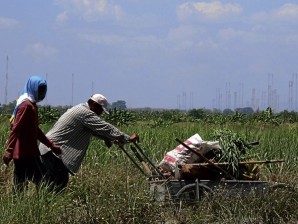Aging farmers, land leases stalk Hacienda Luisita, says study

HARD TOIL Thorns along their path and the seething heat do not discourage farmers of Hacienda Luisita in Mapalacsao village in Tarlac City from doing their daily work in the fields. Last week, the Supreme Court upheld with finality their ownership of land parcels in the sugar estate. EV ESPIRITU / INQUIRER NORTHERN LUZON
Most of the 6,926 farm workers who availed themselves of shares of stock than land parcels in Hacienda Luisita in 1989 and who the Supreme Court upheld as agrarian reform beneficiaries of the sugar estate in Tarlac are either dead or aging, an ongoing study by the Center for Research and Special Studies (CRSS) showed.
The study also found that more than 3,000 hectares of the estate owned by the family of President Aquino in Tarlac had been leased to financiers, who include local politicians and groups connected with Central Azucarera de Tarlac (CAT), a mill within the disputed estate and also owned by the same family.
That area is more than 61 percent of the 4,915.75 ha ordered distributed to farm workers by the high court through its Nov. 22, 2011, decision and half of the original holdings that spanned 6,443 ha, said the CRSS study titled “Sustaining the Agrarian Reform Process Today and Beyond 2014.” The high court’s 2011 decision was affirmed in an order it issued on April 24.
These realities make the implementation of the Supreme Court orders more difficult, said University of the Philippines professor Rene Ofreneo, CRSS director and former dean of the University of the Philippines’ School of Labor and Industrial Relations (UP Solair).
The CRSS study is being undertaken in cooperation with the Catholic Bishops’ Conference of the Philippines’ National Secretariat for Social Action (CBCP Nassa). It covers 13 estates in the country that use the stock distribution option (SDO) and other arrangements done supposedly under the extended and reformed Comprehensive Agrarian Reform Program (CARP).
It is funded by Icco, an interchurch organization for development cooperation based in The Netherlands.
Lack of dev’t vision
“Luisita is a real problem given also the lack of government’s vision of development in Luisita to fulfill the goals of agrarian reform such as social justice. The extension of the CARP ends in August 2014,” Ofreneo said.
Because many of the farm workers-beneficiaries (FWBs) are dead, he said the Department of Agrarian Reform (DAR) should now clarify who should succeed them.
The process of excluding or including CARP beneficiaries is a task by the DAR beginning at the barangay agrarian reform chair, municipal agrarian reform officer and regional director. The DAR central office has the power to review the decision of the regional director.
The FWBs reached by the study believed that the influence of the Cojuangcos pervades in all these levels, Ofreneo said.
Only 10 percent of the original FWBs were 18 years old at the time when the SDO was approved between the Cojuangcos’ Tarlac Development Corp. and the FWBs who formed the Hacienda Luisita Inc. (HLI), with the latter getting only 30 percent of shares of stock.
The Supreme Court revoked the SDO scheme, saying that “upon a review of the facts and circumstances, we realize that the FWBs will never have control over these agricultural lands for as long as they remain as stockholders of HLI.”
Not sturdy enough
According to the CRSS study, most of the living FWBs are over 60 years old who, by now, are not strong enough to farm and develop the land. Not all their children are inclined to continue farming.
Several financiers have replaced FWBs with farm workers from the Visayas who are paid P120 a day for 12 hours of labor cutting or loading canes.
On the other hand, the lease arrangement, locally called “ariendo,” were started by FWBs after the 2004 riot between government troops and striking workers and after the high court issued a temporary restraining order stopping the DAR and the Presidential Agrarian Reform Council (PARC) from placing Hacienda Luisita under the coverage of CARP.
Antonio Ligon, HLI lawyer, said the firm or the Cojuangco family did not approve the ariendo.
Land rentals
According to the study, the lands were either taken by the FWBs or assigned by the barangay council to them. The original purpose was to fill the shortage of food or lack of employment when the mill shut down.
Financiers, mostly sugarcane growers, rented the lands from the FWBs or village councils at P10,000 per ha a year. The financiers gave another P1,000 to the councils for social programs and P30 for every ton of canes to the sugar mill as their contribution to the payment of real property taxes, the study showed.
“The ariendo explains the survival of the farmers and the mill’s continuing operations. The DAR has to look at this. It shows the need of FWBs for agricultural credit to develop the lands to be distributed to them,” Ofreneo said.
The FWBs and the village councils entered into ariendo that are effective until 2015. Ofreneo, however, said this should be set aside when CARP is implemented in Hacienda Luisita.
“The challenge to [President Aquino] is to transcend his class origin. He should be a President for the farmers and the country,” Ofreneo said.














